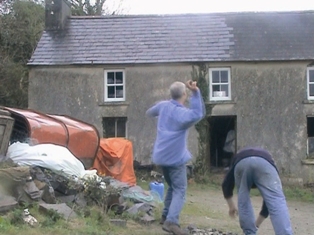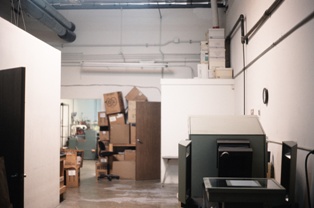Process Room, 08.05.07- 20.05.07
Both projects presented in the Process Room, National Balloon and Windows Blowing Out can be understood as a summary of the interests that have guided my work during the last three years. Both projects have centred around the carrying out of exercises, based on processes and experiences. Situations are raised in which the challenge contained in them determines the scale and possibilities of the work. The productivity of this effort is questioned when the results are presented through a variety of documentation that, because of their sketchy information or because of the unreliability of the medium, work like simple suggestions of the event.
These ways of presentation create a departure point to analyze a practical way of creating a type of work that can survive on its possibilities of oral communication rather than its visual elements.
National Balloon and Windows Blowing Out both represent my interest in the historical revision of referential situations (in these specific cases originating in the artistic circuit), taking them to a place of personal experience, using mainly the diverse possibilities of drawing, like an historical document and a tool of recovery for the memory.
National Balloon, slide show (13 images) and 44 drawings, 2006
On 19 November 1971, the artist Chris Burden carried out the performance Shoot at the F-Space Gallery in Santa Ana, California. The work consisted in asking a friend to shoot him in the left arm with a 22 calibre rifle. All that survives to record this event is an 8-second film and a few photographs.
In his early performances, Burden made the distinction between what he called primary and secondary audiences very clear: the former were those who witnessed the event, the latter those that heard or read about it. The combination of this lack of documentation of the performances, his selection of witnesses, the passing of time and the rumours they awakened brought into being a type of work which has been spread, to date, primarily in the form of legend.
The performance Shoot and the fall-out from it form the basis for the work I now present. My intention is to find ways of symbolically overcoming my role as an absent, passive, distant spectator by using my own experience to recover the performance, becoming, in a figurative temporary way, a live spectator.
The project started out with the simple aim of having a conversation or interview with Burden himself but, as it evolved, my attention strayed more and more towards the elements that were thrown up during the complicated process of trying to persuade the artist to agree. I finally reached a point at which, without losing sight of my initial objective, these elements that I had gathered from all my meetings with people connected to the story, the information I had compiled, my visits to places associated with the performance and the very journey I made to Los Angeles as part of my quest became the ingredients for my work. For this reason, National Balloon is based, not only on Shoot, but also on the fall-out from it, the traces that remain from it, the interpretations that have sprung up and the artist’s response to them.
The project title is taken from the name of the company which now occupies the premises that housed the F-Space gallery all those years ago, and which is engaged in printing and selling balloons. I had always meant to visit this place, but I never imagined that it would be so difficult to find a document or person that would give me a clue as to its whereabouts. This complication, added to all the negotiations necessary to visit the company, made it more and more important for me to go there.
After several attempts, I finally managed to persuade the company owner to let me look around the premises and to grant me the time I needed to tell him what had happened there 35 years before. During our conversation, I saw that he had become most curious about it all, and I thought that from that day on the place would never seem the same to him again. I also realised that my own reading of Shoot had changed. The time I had spent travelling and all the elements I had found had become inextricably related to the video, the photos and the texts on the performance that I was familiar with.
The documentation from this experience consists of some photographs I took during my exploration at National Balloon and a selection of drawings of sites, interpretations, conversations and people involved over the course of the project; most of them made from memories conserved during the trip. These images are not intended to tell a story in a linear way; rather, they form a subjective documentation, behind an experience, which revolves around the specific events.
Windows Blowing Out, DVD, 6’44” min loop. 2005
In December 1976 the artist Gordon Matta Clark was invited to participate in a collective exhibition titled “Ideas as a model” that took place in the attic of the Institute for Architecture and Urban Studies in New York, where he would show together with other architects like Richard Meier, Graves and Guatheney. Together with Peter Eisenman who was the director of the institute, they represented the formalist current at that time, which emerged from Cornell University, where Matta Clark had studied. But Matta Clark rejected their theories critically.
Matta Clark exhibited pictures of the urban disaster of South Bronx, where you could see abandoned buildings, revealing signs of how little importance was given to the public housing issues those days by architectural theory in The United States. The attack was clear; Meier himself had built some of these buildings.
From his first works on, Gordon Matta Clark searched for a territory of action clearly different from the conventions of his architectural education, drifting into abandoned territories, the sky, the subsoil, working with materials from trash to organic resources.
On the previous night to Matta Clark’s exhibition, he borrowed an air-gun from his friend Dennis Oppenheim and shot against the windows of the Institute of Architecture where the exhibition was located. Eisenman ordered to exchange quickly the glasses before the opening and condemned the gesture comparing it with the Nazi Kristalnacht. This work was titled Windows Blow Out. Writings on Matta Clark. Salamanca University. Various authors.
My project consisted of the recovery, in "an almost theatrical" way, of this referential work through the construction of three windows, made to size, to be installed in an old abandoned house near the town of Skibbereen, in West Cork, where I was invited to make a site specific project. The windows were installed and then stones were thrown against their glass. Following this act the windows were extracted leaving the house in its original state.
By recreating the original act I recovered and assimilated that simple procedure of Matta Clark and his intention of substituting the model of a visually oriented art-work with a model based on the world of work where the character of process acquires an essential importance. In this particular case, I like the way this piece has survived. The legendary aspect acquired from the mixture of the spectacle of the event, the almost no presence of witnesses and the scarce documentation and information about the event itself.
Putting my own windows in, breaking them and taking them out, the protest does not exist; it can only be seen as an attack against my own structures. It is a caricature of an attack. When taking out the broken windows I made the work absurd and paradoxically the focus of attention is transferred to the energy invested in the useless process.
The video that I present here is an edited version of the action, which lasted approximately one hour. Shortly before the opening of the exhibition that was organized in Skibbereen I decided not to show this video, the commentaries and rumours of the locals and audience were sufficient to spread this work even though there were no witnesses, with the exception of the camera operators.
Born in Mexico in 1979, over the last five years Jorge Satorre has lived and worked in Barcelona, Spain. Satorre combines his practice as an artist with that as an editorial illustrator. His work had been presented in a solo show in La Casa Encendida, Madrid, 2006 and in the West Cork Arts Centre, 2007. He has been a resident artist in: HANGAR, Barcelona, 2003-05; FLACC, Genk, Belgium, 2004 and has a forthcoming residency at Le Pavillon / Palais de Tokyo, Paris, 2007-08. He received first prize in the IV Vic Biennale, the Premio Miquel Casablancas 2006 and his residency at IMMA is kindly supported by the Departament de Cultura, Generalitat de Catalunya, 2007.
For a printable version of this information please download the following document Jorge Satorre: The Happy Failure (Word doc 2000 – 39KB)
Click here to return to Previous Participants
Click  here to browse ARP Projects
here to browse ARP Projects

